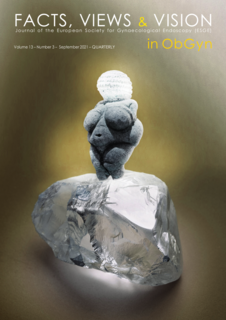Minimally invasive management of juvenile cystic adenomyoma: report of three cases
Juvenile cystic adenomyosis, chronic pelvic pain, minimally invasive surgical management
Published online: Sep 24 2021
Abstract
Background: Juvenile cystic adenomyosis (JCA) represents a rare form of focal adenomyosis in young women.
Objectives: To determine safety and effectiveness of minimally invasive surgery (MIS for JCA).
Materials and Methods: Three patients aged 16-30 years old presented with chronic pelvic pain [2016 - 2019]. Hormonal treatment failed in two cases. Cystic lesions in the myometrium (n=2), and the broad ligament (n=1) was detected on transvaginal 2D ultrasound (TV 2D US) and/or magnetic resonance imaging (MRI). The cyst was separate from the endometrium in all the cases, within the myometrium in two patients and in the right broad ligament in one case. The cystic lesions were confirmed on laparoscopy; and laparoscopic excision of the cysts with adequate repair of the myometrial beds were performed in all cases with fertility preservation. Robotic assistance was chosen in one case in an attempt to avoid injury of the fallopian tube based on the cyst location during a previous laparoscopy. The endometrial cavity was entered in one case.
Main outcome measures: Absence of intraoperative complications and relief of presenting symptoms postoperatively.
Results: Pathology report confirmed the diagnosis of JCA is all cases. There were no intraoperative complications. All three patients reported relief of their symptoms 6 to 8 months after surgery. No recurrence of the JCA was reported using TV 2D US in all cases.
Conclusions: MIS could be the treatment of choice for patients with JCA. The technique described in our study is safe, effective, and easy to master in experienced hands.
What is new? Value of MIS in treatment of patients with JCA.



